
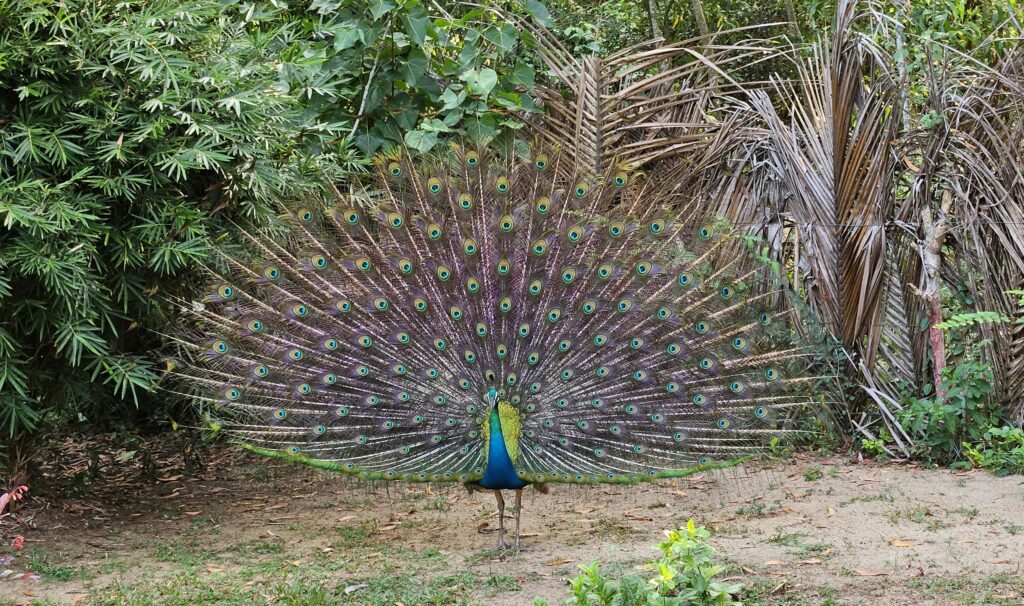
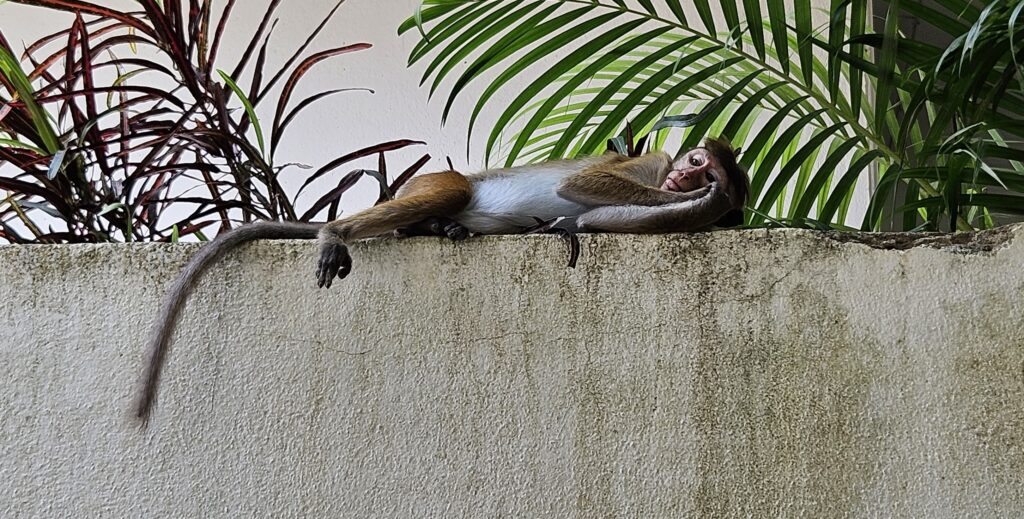
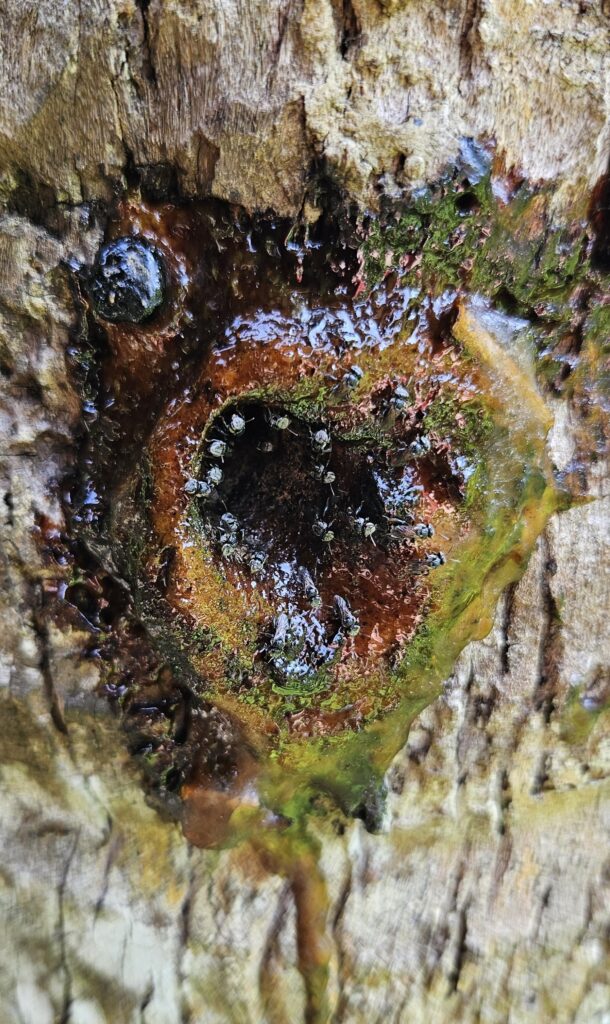
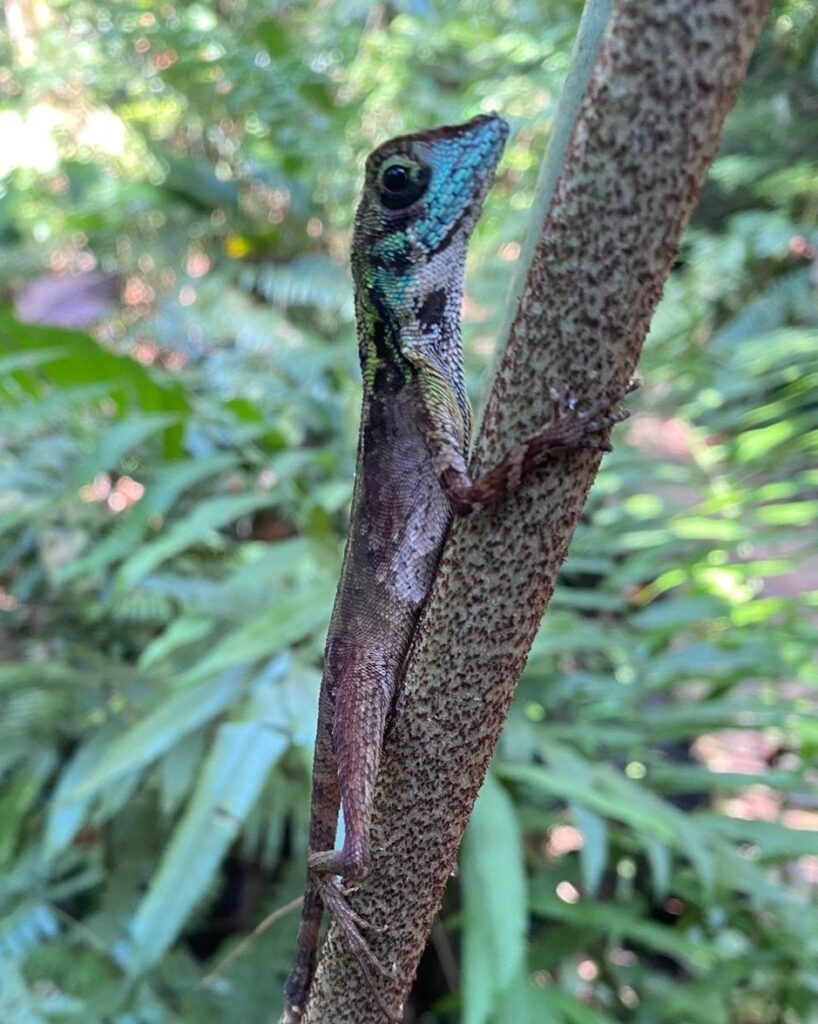
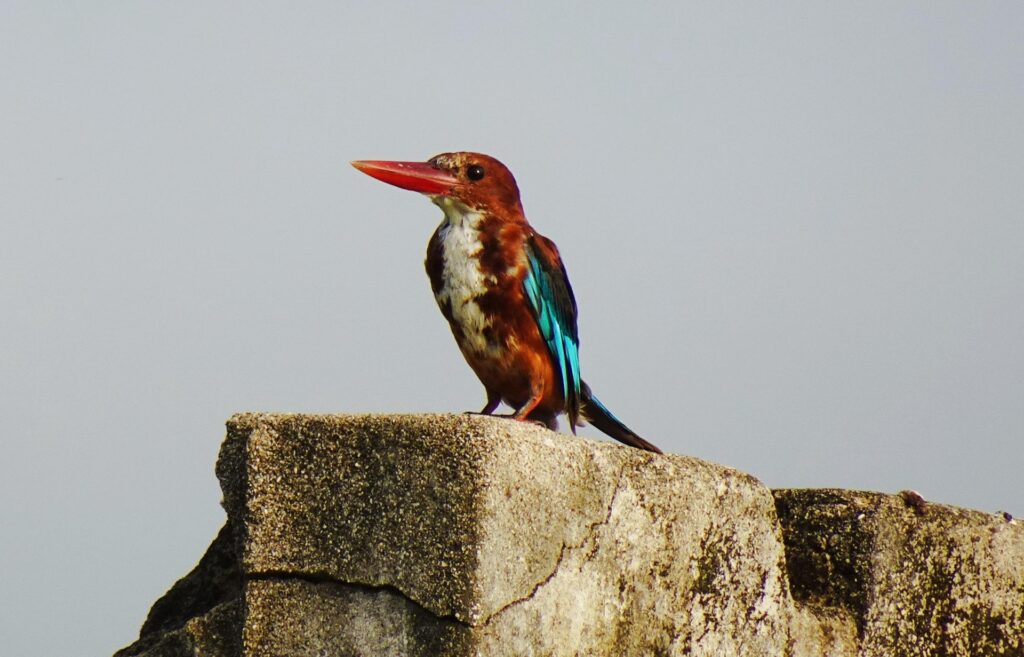
- National Parks
- National Bird Junglefowl
- Animals at Night
- Bats
- Birds
- Crabs
- Dogs
- Fish
- Insects
- Leeches
- Lizards
- Monitor Lizards
- Lorises
- Mongooses
- Monkeys
- Peafowls
- Sea Turtles
- Scorpions
- Snails and Frogs
- Snakes
- Squirrels
- Water Buffalo
Wildlife in Sri Lanka
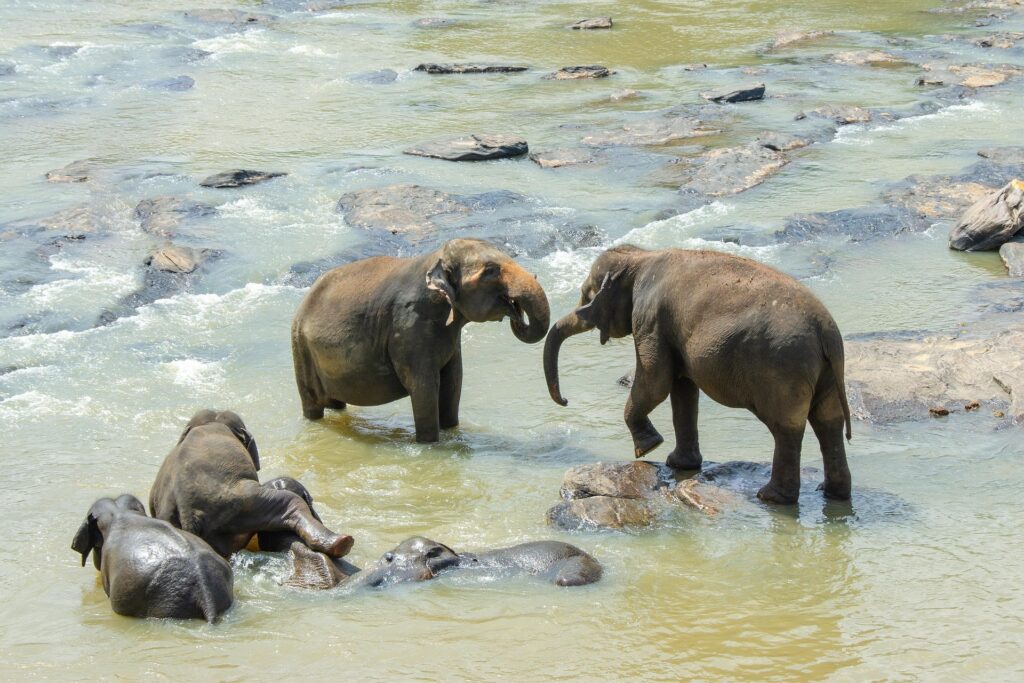
National Parks
One of the most well-known animals in Sri Lanka is the Sri Lankan elephant (Elephas maximus maximus), an endemic subspecies of the Asian elephant (Elephas maximus). It is found exclusively on the island and is revered as the national animal.
Especially in Udawalawe National Park and Minneriya National Park, visitors can observe large herds in the wild. Initially, we planned to visit Udawalawe National Park but decided against it on site when we learned that it can also be quite crowded there, although less so than Yala National Park. We avoided Yala from the start because a park full of jeeps stuck in traffic, chasing leopards and other animals, would not have felt comfortable for us.
Instead, we stayed in Tangalle and in Sinharaja, the last remaining primary rainforest in Sri Lanka, which has been declared a UNESCO World Heritage Site due to its unique biodiversity. Even from the terraces of our accommodations, we were able to see and hear plenty of wildlife, at any time of day. It was the right decision for us.
Depending on the accommodation or tour operator, visiting the national parks can still be worthwhile for nature lovers because there are guides who are very knowledgeable, know the animals well, do not disturb them, have suitable 4×4 vehicles, and drive in a way that keeps you away from the crowds, crossing paths only occasionally.
National Bird Junglefowl
While kayaking in the Rekawa Lagoon, we also spotted Sri Lanka’s national bird. We actually heard it before we saw it – something suddenly fluttered in the trees: the endemic Sri Lanka junglefowl (Gallus lafayetii), found only on the island.
The junglefowl symbolizes alertness, courage and vitality, primarily due to its behavior and characteristics. Chickens are highly aware of their surroundings and react quickly to sounds or movements, making them reliable “watchers”. Despite their relatively small size, they often display bold and energetic behavior, actively defending their territory and chicks from threats. Their lively and active nature represents vitality and joy in life, which is why they are valued as a symbol of life force.
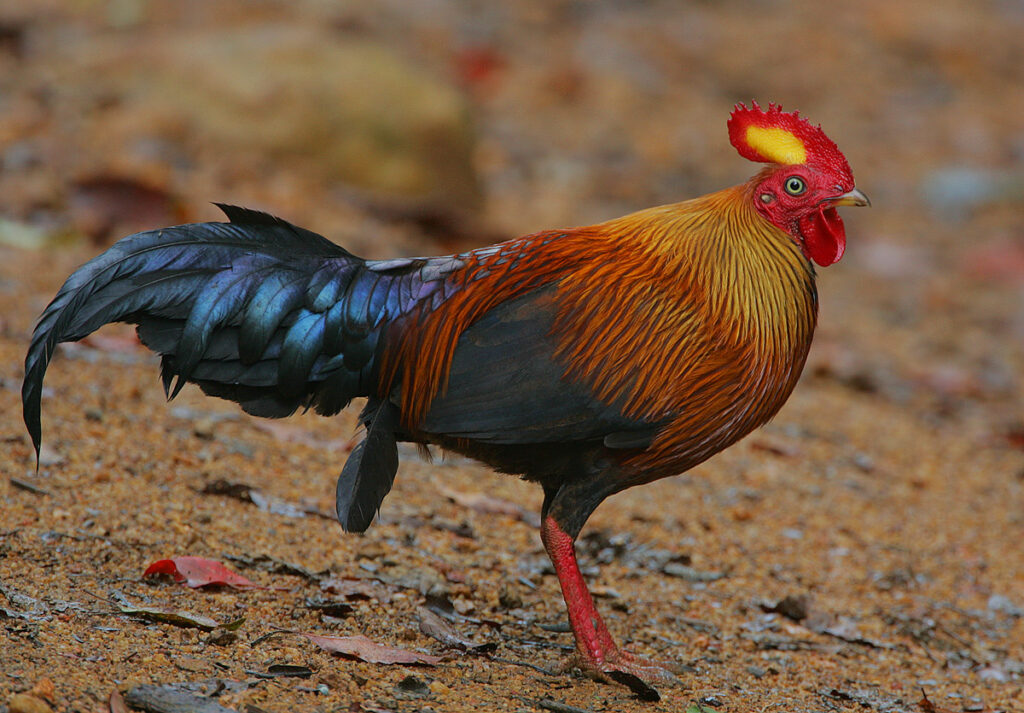
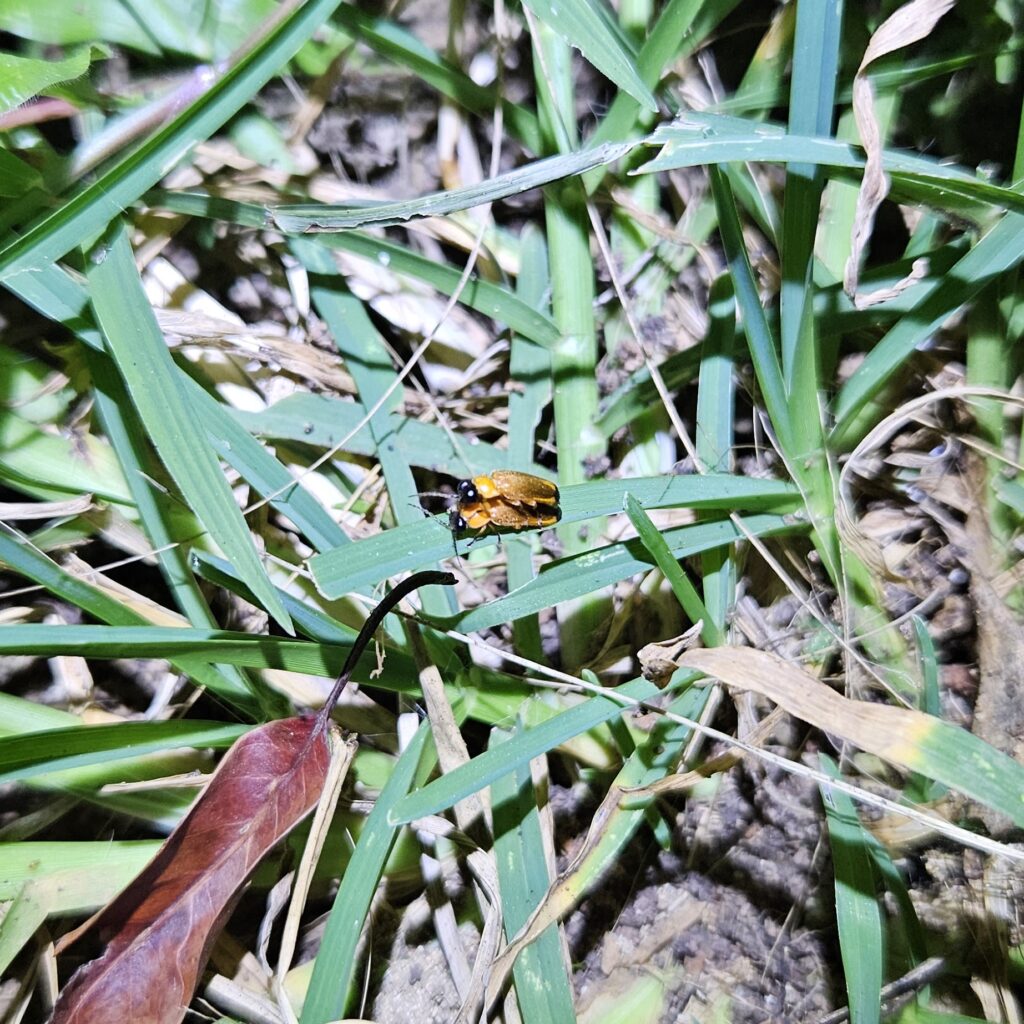
Animals at Night
In Sri Lanka, there are still many fireflies and snakes. This makes the country enchanting even at night. A night hike through the Sinharaja rainforest is something very special. We spent over four hours in the dark. Thanks to our guide, we were able to sit quietly for a long time, listen to the nighttime sounds of the rainforest, and watch countless fireflies. All devices – phones and cameras – were turned off, and we were completely silent. That moment was simply magical.
Bats
At dusk, we regularly saw impressive Indian flying foxes (Pteropus giganteus giganteus) soaring overhead, with wingspans of up to 1.5 meters. They only become truly active at sunset. Flying foxes are indeed bats, just much larger than most other bat species, and with a striking, dog-like face – hence the name flying fox.
Unlike many smaller bats that feed on insects, flying foxes primarily live on fruit and nectar. In their search for food, they perform remarkable ecological services: they pollinate plants, disperse seeds, and play a key role in sustaining forest ecosystems. Here’s how it works:
They bite into fruit, often swallowing only the juicy parts and later spitting out the seeds or pits elsewhere – thus spreading them over long distances. Sometimes, they also carry fruit away and eat it later, which aids in seed dispersal as well.
When feeding on nectar, pollen sticks to their fur or heads. As they move from one blossom to the next, they transfer the pollen and help with pollination – similar to bees. Flying foxes are especially important pollinators for night-blooming plants, since many other animals are not active at night.
Although they might seem intimidating to some people, flying foxes are completely harmless. It’s fascinating to watch them, and Sri Lanka offers excellent opportunities to do just that.
We also saw the smaller bats. Every night in the Sinharaja rainforest, we were visited by a Schneider’s leaf-nosed bat (Hipposideros speoris), which seemed to perform a little dance just for us.
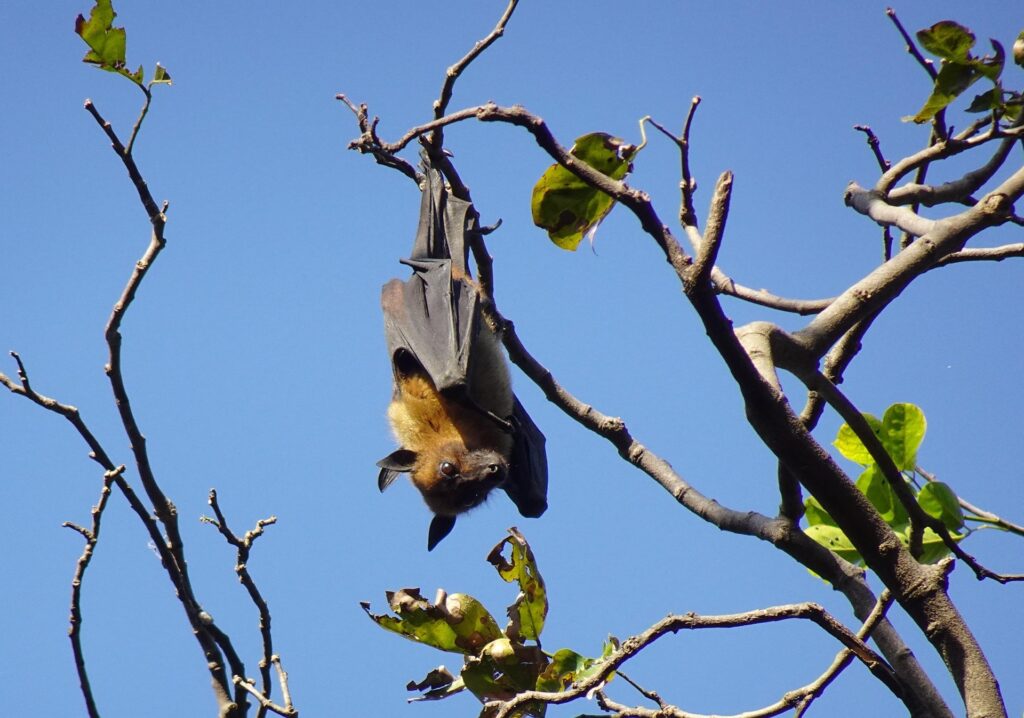
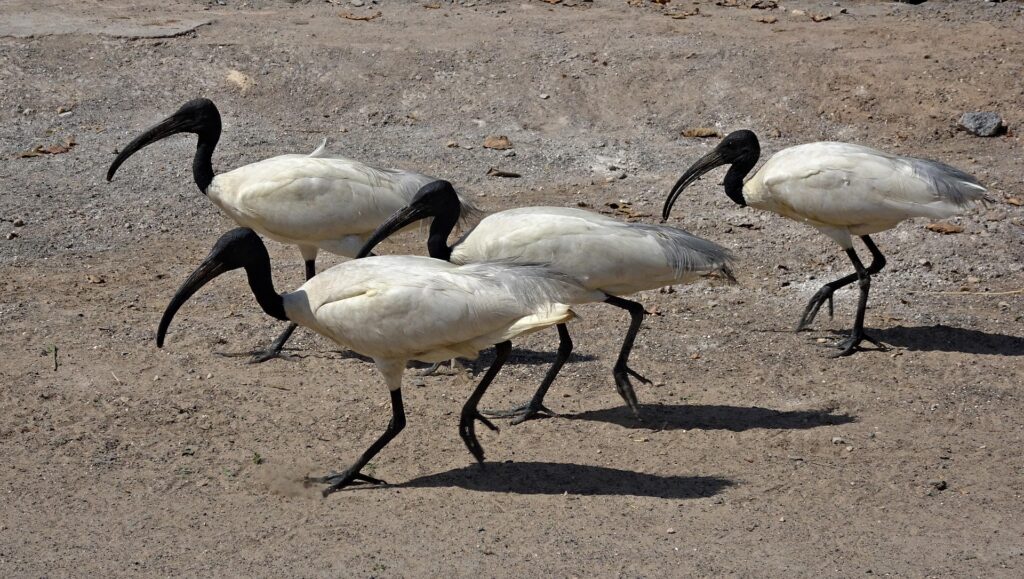
Birds
With over 400 bird species, including many endemic ones, Sri Lanka is a true paradise for bird lovers. Just like the colorful butterflies, we could only catch fleeting glimpses of many birds, especially around the Rekawa Lagoon near Tangalle and in the Sinharaja rainforest.
Among them were kingfishers like the white-breasted kingfisher (Halcyon smyrnensis), endemic and particularly swift Layard’s parakeets (Psittacula calthropae), Indian paradise flycatchers (Terpsiphone paradisi), black-headed ibises (Threskiornis melanocephalus), a pelican seen from afar, various heron species, and – rarely seen during the day – an endemic brown fish owl (Ketupa zeylonensis zeylonensis).
Crabs
Crabs are particularly fascinating, especially because of their diversity. We saw land hermit crabs (Coenobita rugosus), which feed on both plant and animal matter. At dusk or during the night, they always seem a bit spooky. They’re often found near bushes along the beach, and without a flashlight, you really have to be careful not to accidentally step on them.
One especially memorable encounter was with a mangrove crab, likely a blue land crab (Cardisoma guanhumi), which seemed very curious and almost appeared to be trying to communicate with us. We stared at each other for quite some time, and eventually the crab began making slow movements with one of its claws toward its mouth, as if it were eating. Was it trying to tell us it wanted food? It certainly left a lasting impression. We did notice its bristly legs, which made us unsure if it truly was a blue land crab. Another interesting species we spotted was the spotted or yellow moon crab (Ashtoret lunaris), which stood out due to its unique shape.
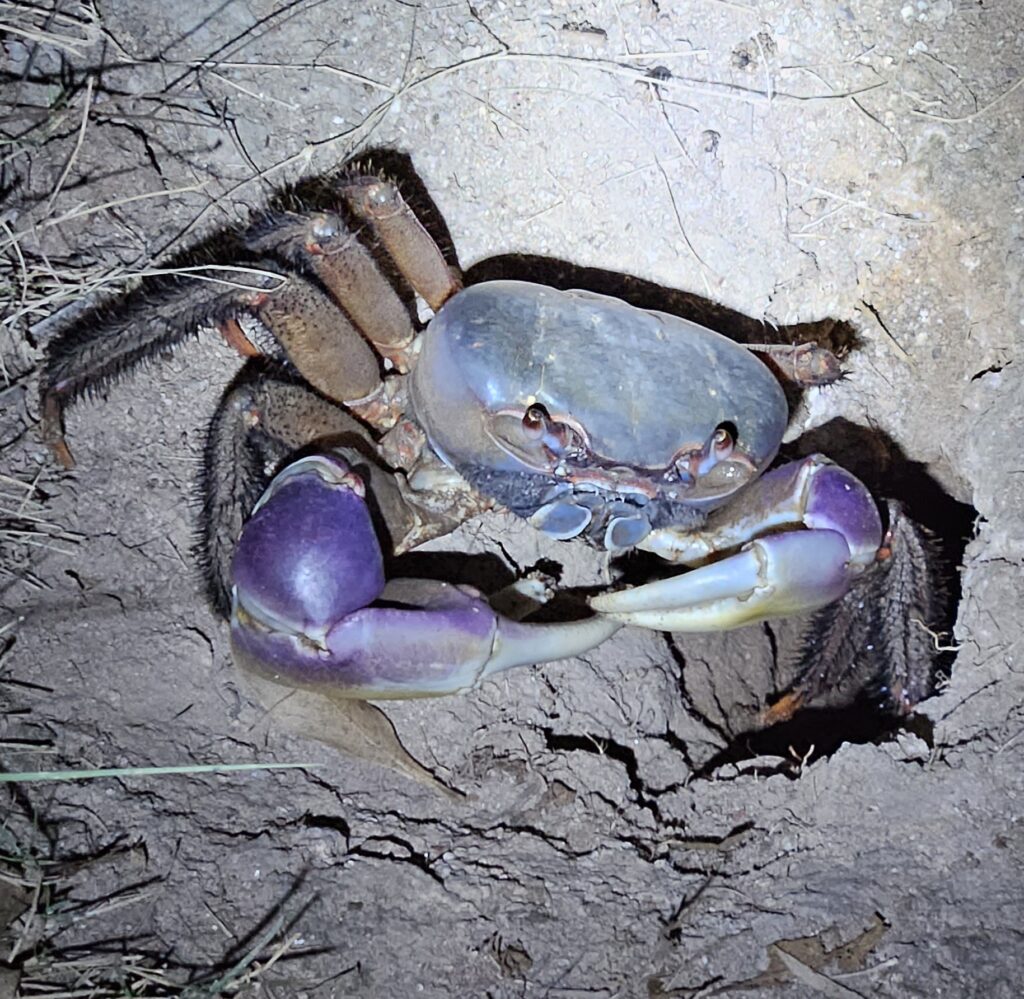

Dogs
We found the street dogs in Sri Lanka to be especially pleasant. Particularly in Tangalle, they were very friendly animals who accompanied us every morning on our way to the beach and back again in the evening – though only as far as their individual territory would allow. We miss them, as they were wonderful companions along the way.
Fish
In the freshwater of Sinharaja, in the rivers and near waterfalls, we spotted beautiful Golden Mahseer (Tor putitora). They were juveniles, as these fish can grow over two meters long and weigh more than 50 kg. Their name reflects this, since “maha” means “large” in the ancient Sanskrit language. Due to their golden color, they are considered divine and have been revered for thousands of years throughout the Indian subcontinent.
Because this carp species is sensitive to disturbances, its presence indicates good water quality and a stable, healthy ecosystem. Today, this popular food fish is classified as critically endangered.
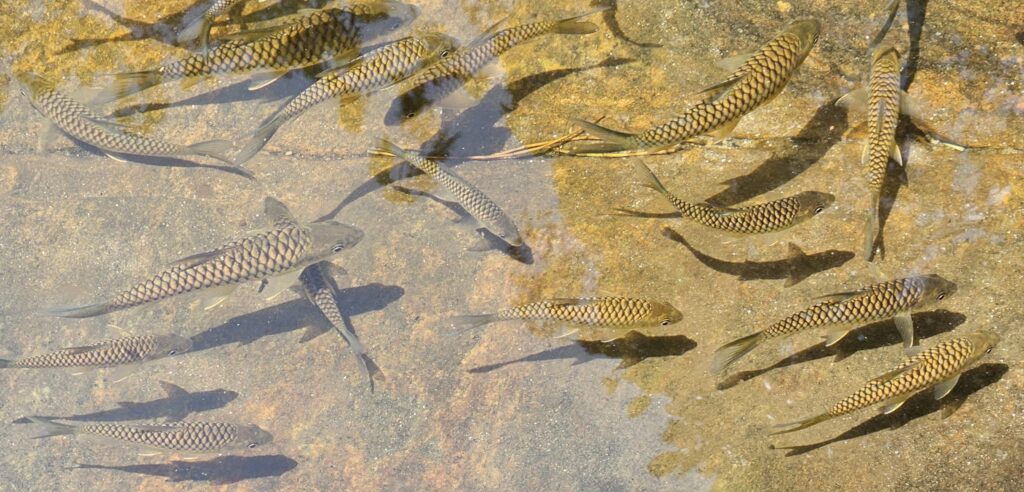
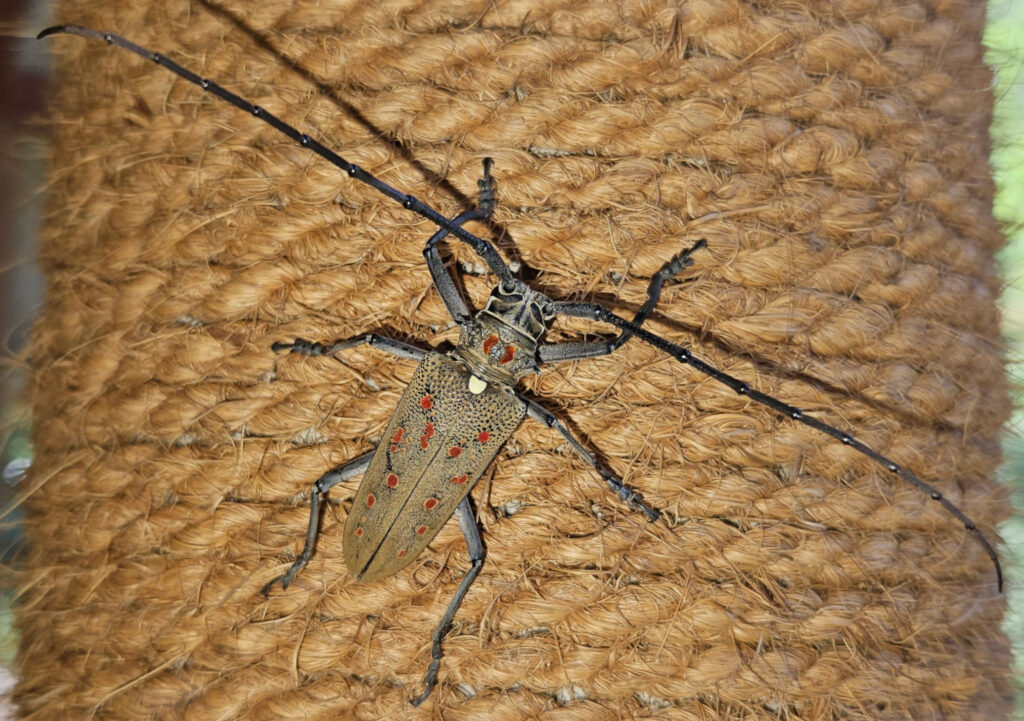
Insects
When it comes to insects, they seem almost countless. Besides butterflies, moths, and their caterpillars, there are beetles, grasshoppers, spiders, hymenopterans like ants and bees, as well as dragonflies.
What stayed with us are the dammar bees (Tetragonula iridipennis, also known as Indian stingless bee) and carpenter bees (Xylocopa), as well as cicadas, including the black-and-white lantern bug (Pyrops maculatus). Its characteristic snout originally gave the cicada its name because people once thought it would glow at night.
Right at our accommodation, we discovered an impressive, hand-sized longhorn beetle (Batocera rufomaculata), whose larvae bore into the trunks of fruit trees. Up close, we also observed the Indian giant praying mantis (Hierodula membranacea) and a tussock moth caterpillar (there are several types). Among the butterflies, the black and red common rose (Pachliopta) left a strong impression, as well as the orange butterfly species tawny coster (Acraea terpsicore), which we saw in great numbers.
There are insects that imitate a brown or green leaf for camouflage, including the brown leaf mimic katydid (Typophyllum laciniosum) and the green Molpa bilineolata. The ghost mantises are, as their name suggests, almost invisible. Also impressive were the giant millipedes (Ktenostreptus centrurus) and the hand-sized golden orb weaver spider (Nephila pilipes pilipes).
Leeches
In the forest, we encountered leeches for the first time – so-called Ceylon leeches (Haemadipsa zeylanica). Despite wearing anti-leech socks and coating our shoes with salt, they managed to crawl under our shirts and pants. We even watched some of them climbing up live: at first, they were thin and long, but after feeding on blood, they became thick and swollen. Aside from the blood-stained clothes, it was not particularly unpleasant; the bite sites were painless and soon showed no trace at all. The little bloodsuckers were mostly active at night; during the day, we rarely came across them.

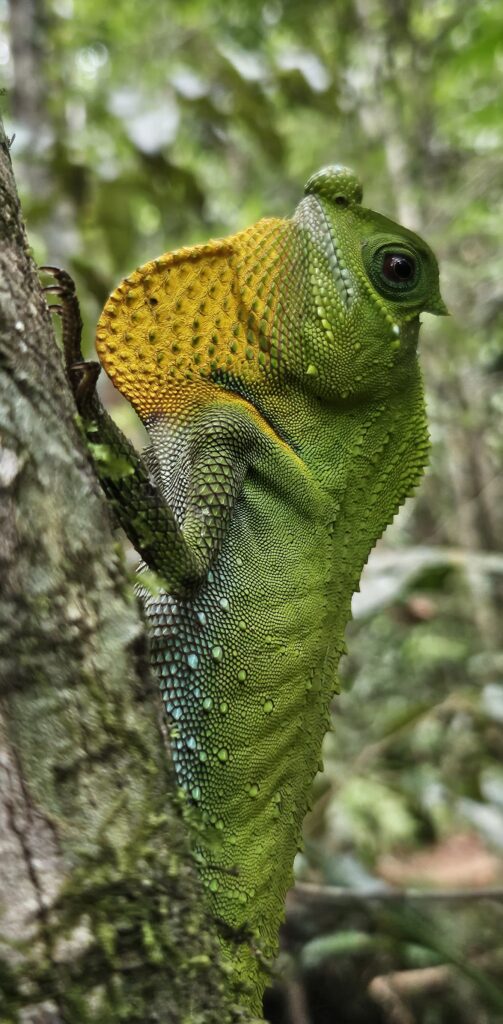
Lizards
Among the diverse reptiles in Sri Lanka are the agamid lizards. They form their own family within the lizard group. Many of them are endemic, meaning they are found only in Sri Lanka and nowhere else in the world.
This includes the Sri Lanka agama (also known as the whistling lizard, Calotes liolepis) and the kangaroo agama (Otocryptis wiegmanni), which can sprint quickly on its large hind legs when sensing danger.
In Sinharaja, we discovered an impressive hump-nosed agama, the largest endemic agamid species in Sri Lanka (Lyriocephalus). It is also called lyreshead lizard. The name refers to the distinctive shape of the male’s head, which resembles a lyre, an ancient stringed instrument.
We spotted bloodsucker agamas (also known as oriental garden lizard, Calotes versicolor), which, like chameleons, can change their color and move each eye independently in different directions. The name comes from the intense red to blood-red coloration that males display during the mating season, especially on the head and neck. This striking display has led to the nickname “bloodsucker” in some Asian countries.
We almost walked past a well-camouflaged green forest lizard (Calotes calotes), hidden perfectly in the foliage. Normally, we’re quite good at spotting animals – but this one was simply impossible to find in the bush until the amused ranger finally showed it to us. It’s truly amazing how well some lizards can blend into their surroundings.
Monitor Lizards
Besides reptiles like turtles, snakes, lizards and geckos, we also saw monitor lizards – on land especially the Bengal monitor (Varanus bengalensis) and in the lagoons the water monitor (Varanus salvator salvator). The animals appeared very majestic to us and seemed to embody calmness itself.
Monitor lizards primarily feed on insects, small reptiles, amphibians, fish, eggs, small birds and occasionally carrion. They are opportunistic omnivores, adapting their diet to what’s available in their habitat.
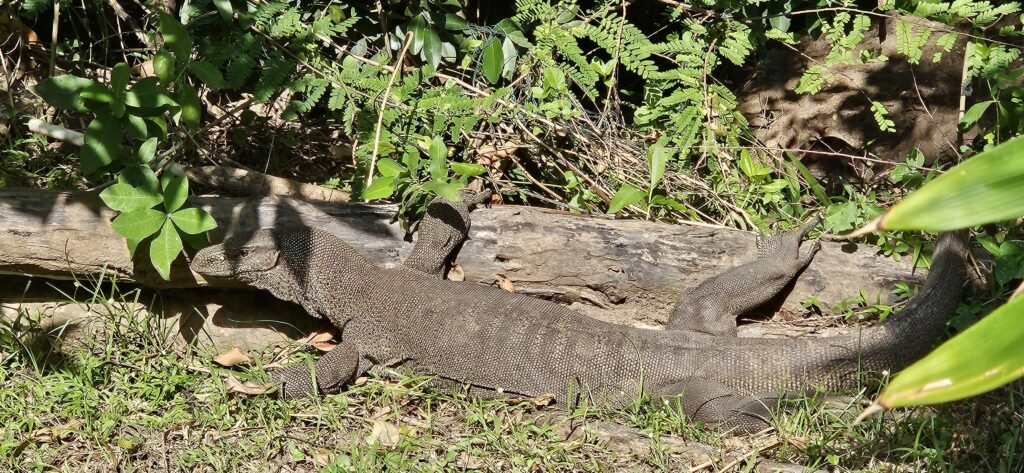
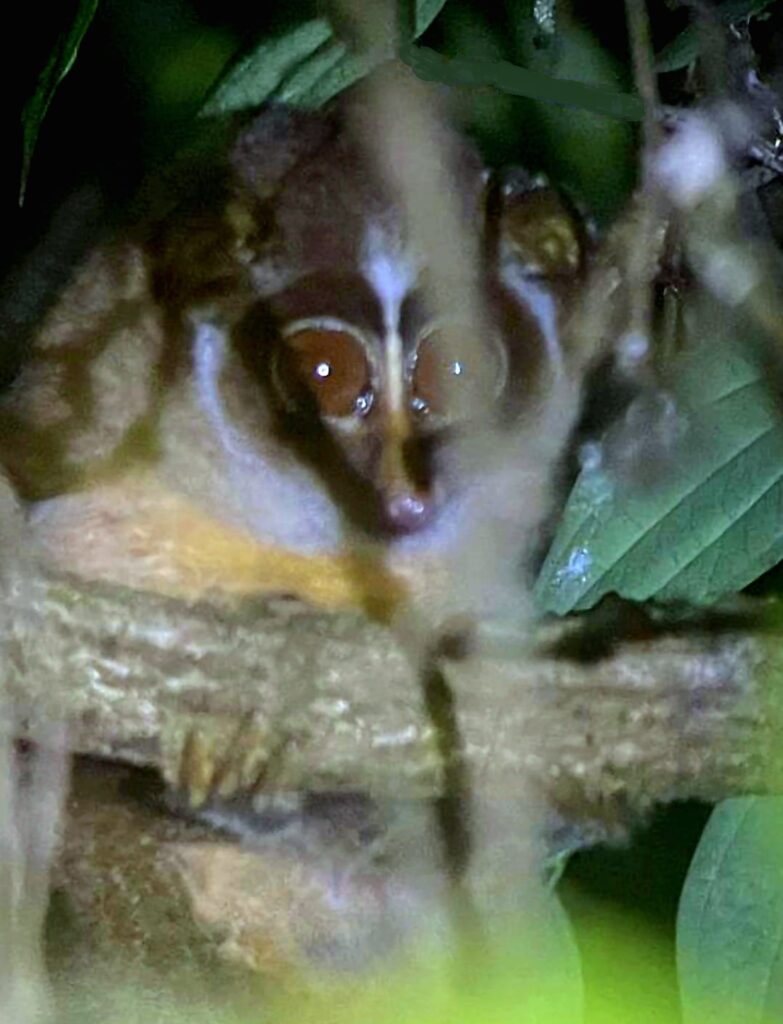
Lorises
The small, nocturnal lorises (Lorisidae) are among the most fascinating, but also the most elusive inhabitants of tropical forests. With their large, round eyes perfectly adapted to the dark, they roam the dense rainforest canopy during the night.
Sri Lanka is home to the red slender loris (Loris tardigradus), an endemic species found nowhere else in the world. It is highly endangered due to habitat loss. Protected areas like the Sinharaja Forest Reserve still offer these sensitive primates important refuges.
These animals are extremely shy and move slowly and almost silently from branch to branch – a behavior that earned them the German nickname “Faulaffen” (lazy monkeys). But this apparent sluggishness is actually a highly specialized survival strategy: their deliberate movements help them stay undetected – by both predators and curious humans.
Spotting one is a rare and precious experience. As in our case, it usually requires a knowledgeable local guide and a nighttime forest walk.
Mongooses
We saw mongooses for the first time in Sri Lanka, although only from a distance. These small, nimble predators quickly disappeared back into the bushes – just like the hares, more specifically the Indian hares (Lepus nigricollis nigricollis).
Several species of mongoose live in Sri Lanka. The most commonly seen is the Indian grey mongoose (Herpestes edwardsii), recognizable by its grey-brown fur and long bushy tail. It is known for its speed and courage – even cobras are among its prey, which is why mongooses are considered lucky animals in some cultures.
Mongooses are mostly active during the day and move skillfully through scrubland, fields, and forest edges. They are often seen by the roadside or darting through the undergrowth. The best chances to spot a mongoose are early in the morning or at dusk. They usually live alone or in small groups and feed on insects, small vertebrates, eggs and fruit.
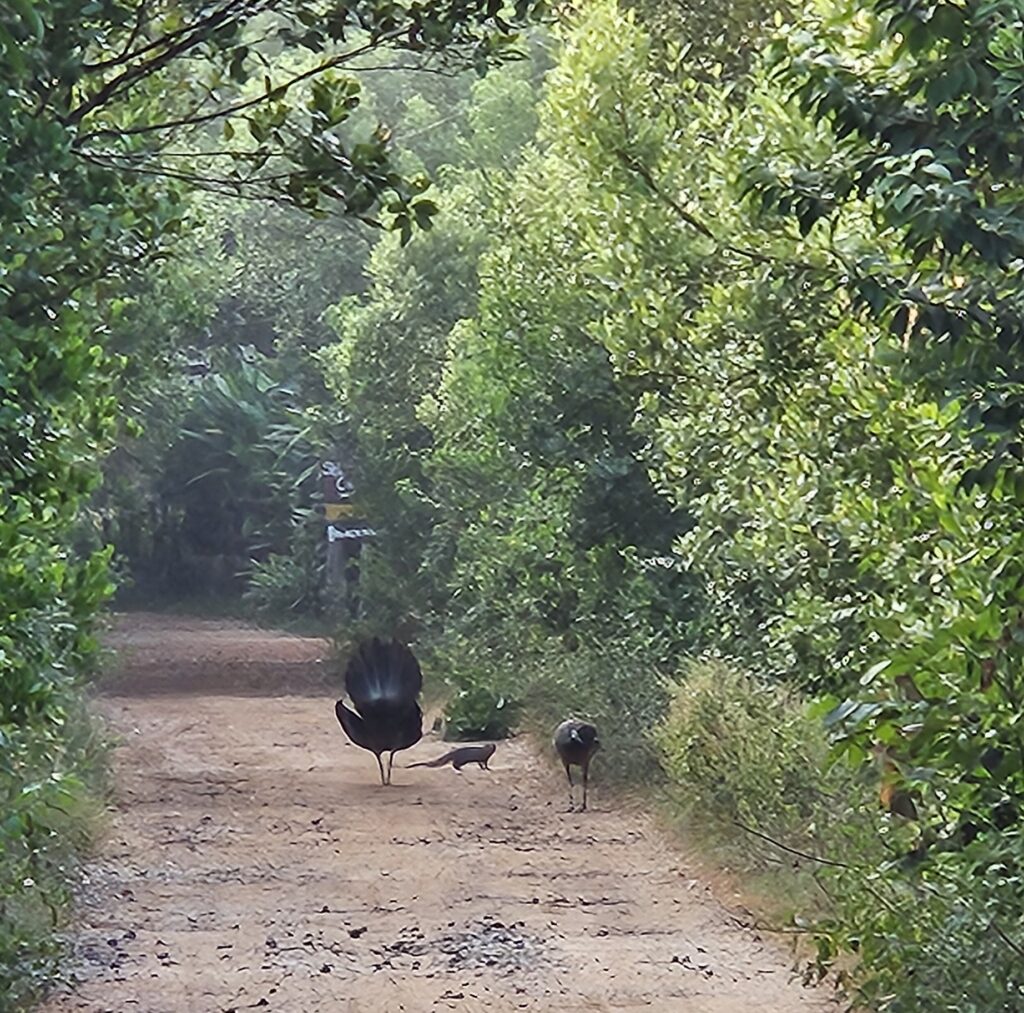
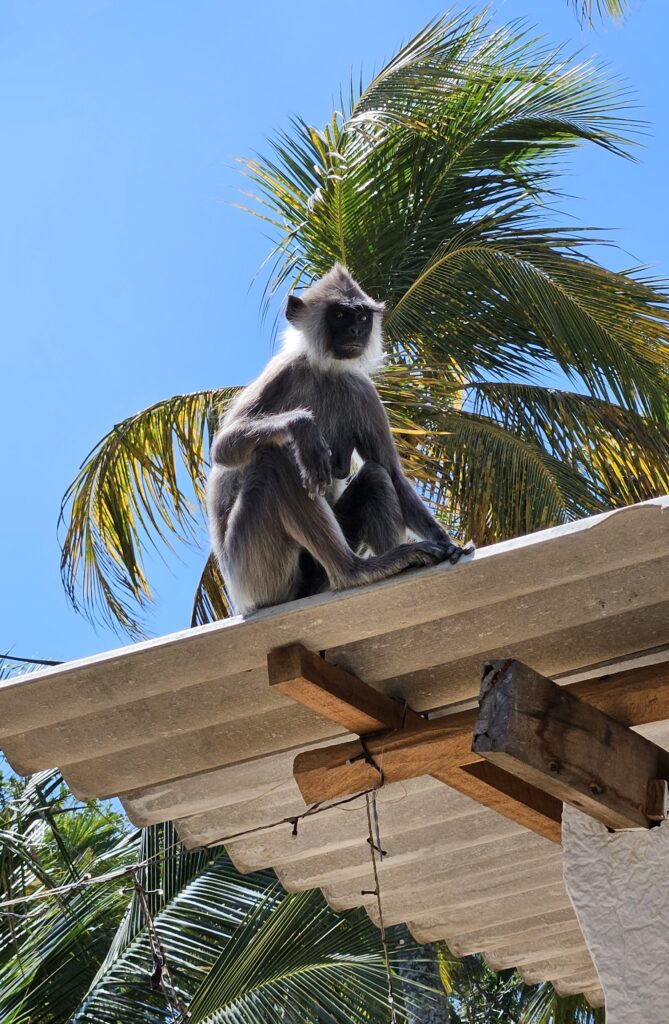
Monkeys
In Sri Lanka, we frequently encountered two species of monkeys; both belong to the Old World monkeys: the endemic Ceylon toque macaque (Macaca sinica) and the tufted gray langur (Semnopithecus priam thersites). The name “Old World monkeys” refers to the geographic origin of these primates – they evolved in the “Old World”, which traditionally refers to Africa, Asia and Europe. This term contrasts with “New World monkeys”, which evolved in the “New World”, meaning America (Central and South America).
While the langurs mostly ate plants, we observed the macaques eating almost anything – including showing a strong interest in our breakfast. Once, we happily watched two toque macaques performing a sort of trick on our terrace. We just barely noticed that another monkey sneaked up from behind to steal our food. One moment distracted and not paying attention – and it was gone. The macaques in Dikwella and Hiriketiya were especially clever and resourceful in getting something to eat – for example, coming over the roof and entering through the open terrace door while we were looking down.
Peafowls
We have never seen as many blue peafowls (Pavo cristatus) in the wild as we did in Sri Lanka. This bird species is surprisingly quick and can even fly, though only for short distances. Especially around Dikwella, you can feel like you see them on every corner, both on the ground and in the trees.
In Sri Lanka, the blue peafowl is more than just a beautiful bird – it is a religiously revered and culturally significant animal that symbolizes spirituality, grace, beauty, and dignity. Its colorful feathers are considered signs of wealth and elegance. In Hinduism, the peacock is the mount (Vahana) of the war god Murugan (also called Kataragama), who is especially worshiped in Sri Lanka. In many Buddhist depictions, the peacock symbolizes purity, wisdom, and good fortune.
We were especially lucky to witness the impressive and quite long courtship dance of a male. It spread its spectacular plumage covered with over 100 metallic-looking “eyes”. It was amusing to watch how the female, to whom this dance was directed, walked past completely unimpressed.
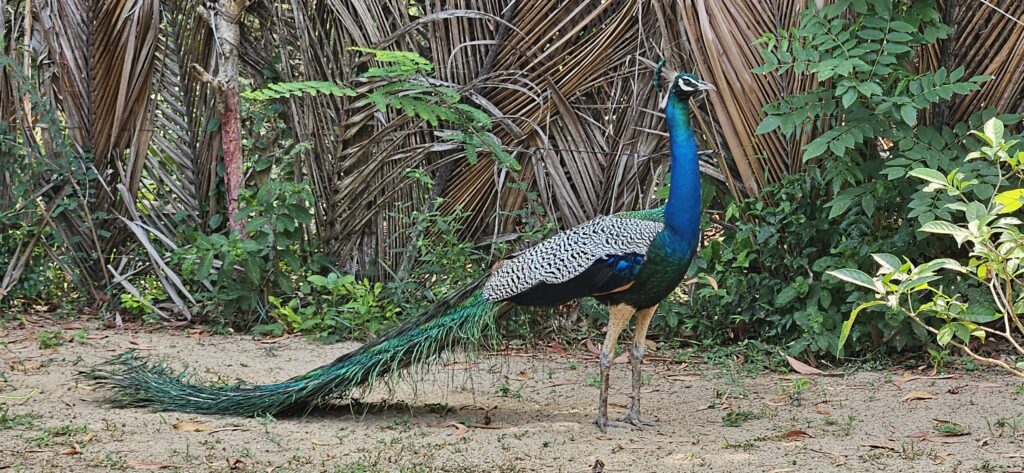
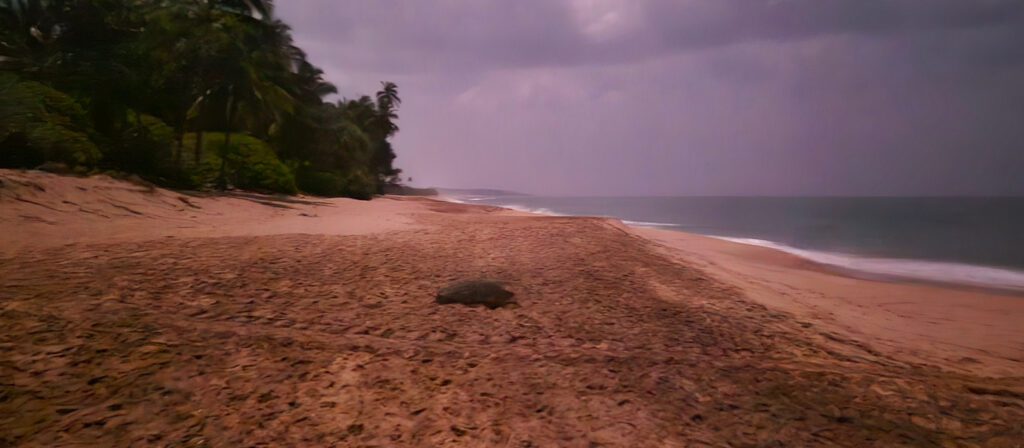
Sea Turtles
We were fascinated by the sea turtles that appear after sunset. Along Sri Lanka’s coasts, five different species come ashore to lay their eggs: Hawksbill (Eretmochelys imbricata), Loggerhead (Caretta caretta), Green sea turtle (Chelonia mydas), Olive Ridley (Lepidochelys olivacea) and Leatherback (Dermochelys coriacea).
We can’t say exactly which ones we saw, as we only glimpsed them from a distance in the dark. It definitely wasn’t the Leatherback, which can grow up to two meters long, because the turtles we saw were smaller – their shells estimated to be about a meter at most. From what we could make out in the moonlight, they were most likely Green or Olive Ridley turtles. We were able to watch the turtles several times quietly and from a respectful distance during our evening walks on the beach. During full moon, you can see their shiny shells from afar and take care to give them space, sometimes waiting patiently until the turtle moves on by itself.
Scorpions
For the first time, we also saw scorpions, which belong to the class of arachnids (Arachnida). In the rainforest, we came across the blue-black Asian forest scorpion (Heterometrus cyaneus). Despite its impressive size of up to 15 centimeters, it’s not truly dangerous to humans. Its venom is comparable to a bee sting: painful, but not life-threatening. During the day, it hides in the moist, loose forest floor, under leaves or wood; at night, it goes hunting for insects.
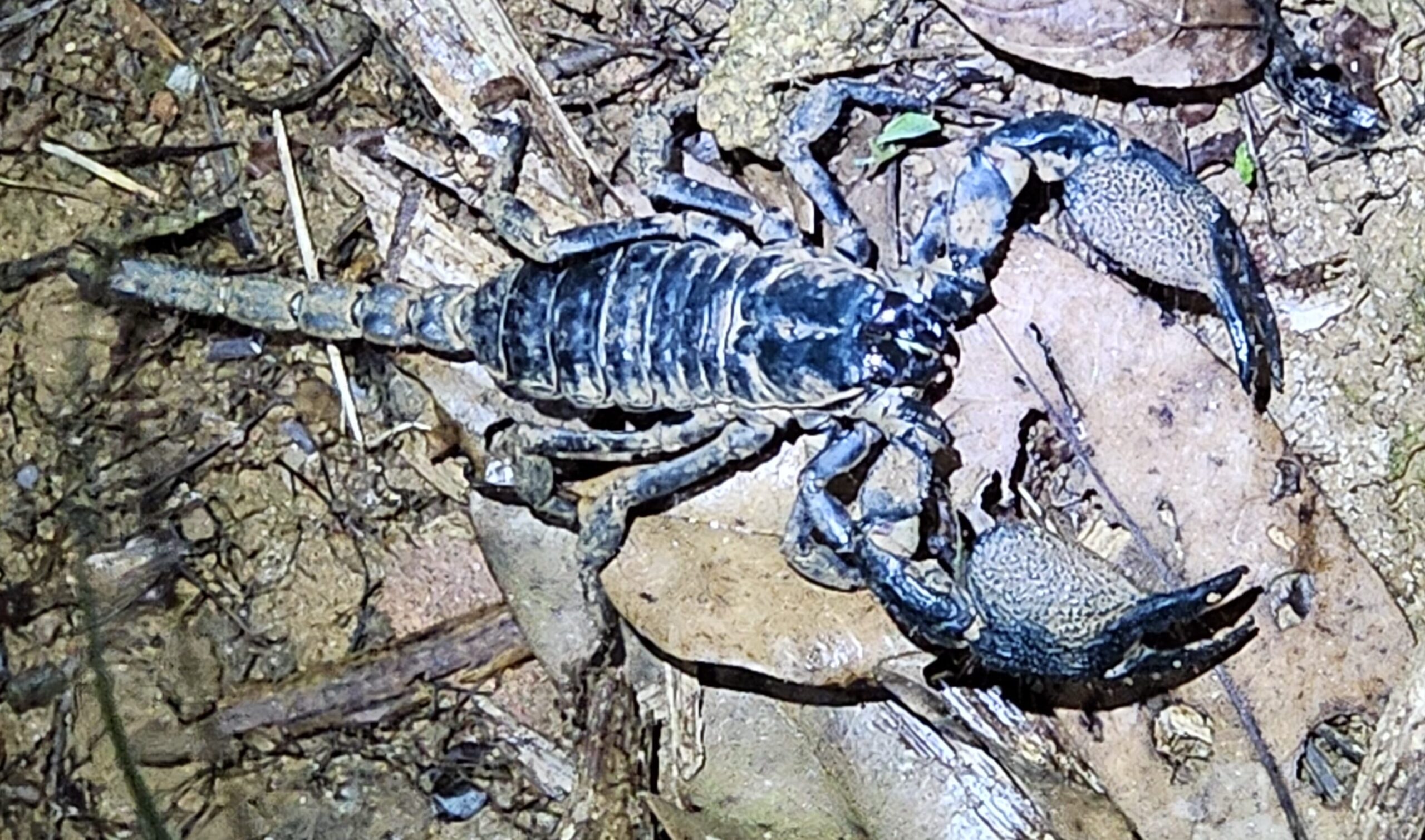
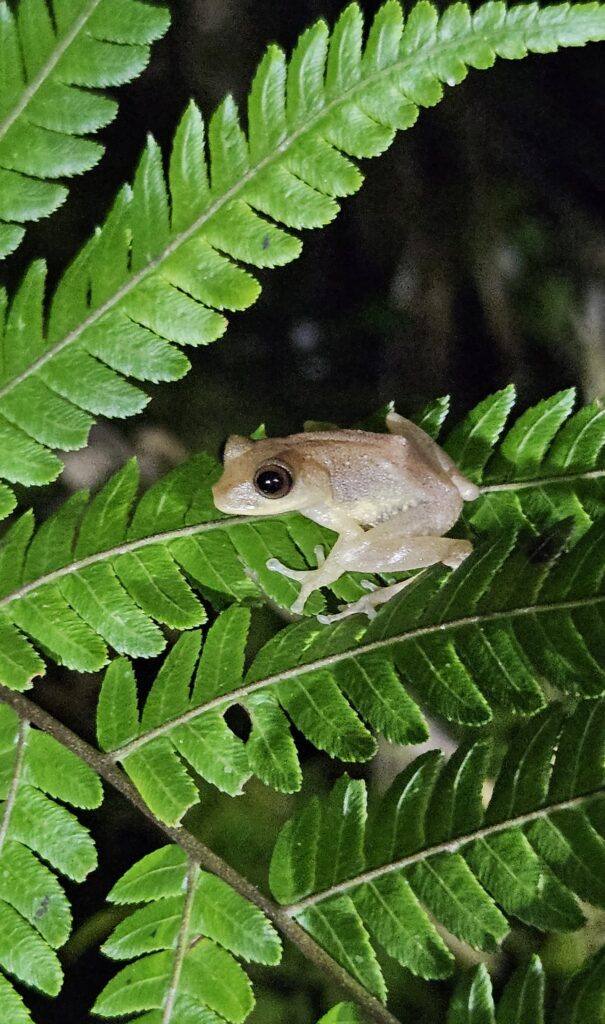
Snails and Frogs
We discovered numerous snails in the Sinharaja rainforest. Amphibian enthusiasts will also be delighted: Sri Lanka is home to many frog species that thrive in the humid rainforest. Especially in the dark, their large black eyes are truly fascinating.
Among others, we encountered the endemic common shrub frog (Pseudophilautus popularis). One evening, a frog with net-like patterned thighs landed on our terrace in Tangalle – another species found only here: Pseudophilautus reticulatus, known as the reticulated thigh frog.
Snakes
We were particularly impressed by the Russell’s viper (Daboia russelii), known for its potent venom and common presence near settlements, making it the most dangerous snake in Southeast Asia. We encountered one at night near the edge of a village on our way to the rainforest and kept a respectful distance.
Other nocturnal snakes we observed for quite some time included a green, mildly venomous green vine snake (Ahaetulla nasuta), a green pit viper with white lips (Trimeresurus albolabris), which is also venomous, and an endemic, harmless Ceylon wolf snake (Lycodon carinatus) found only in Sri Lanka.
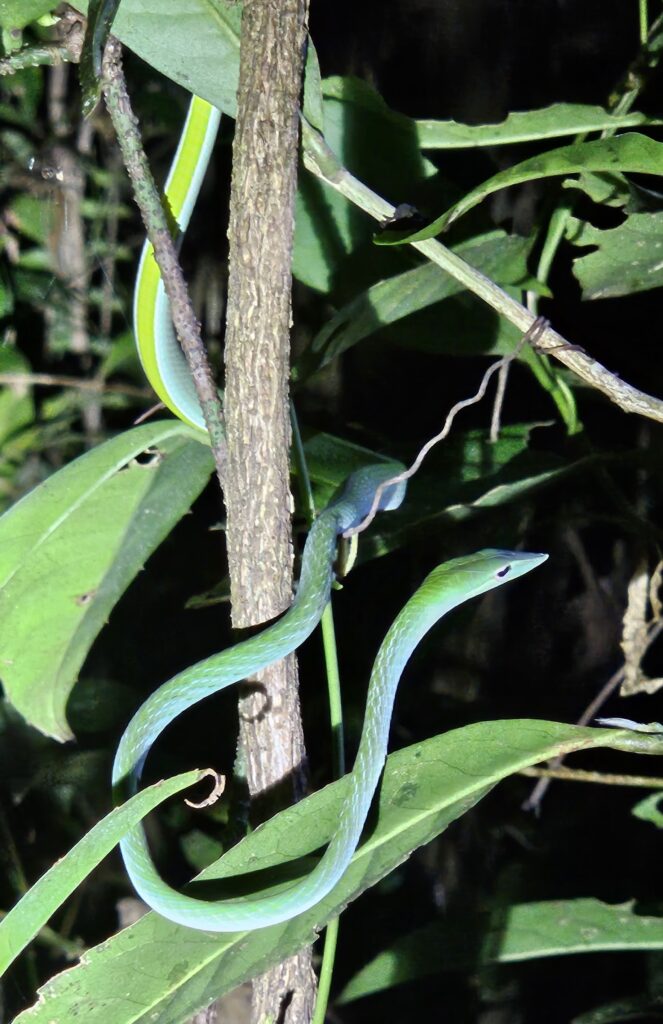
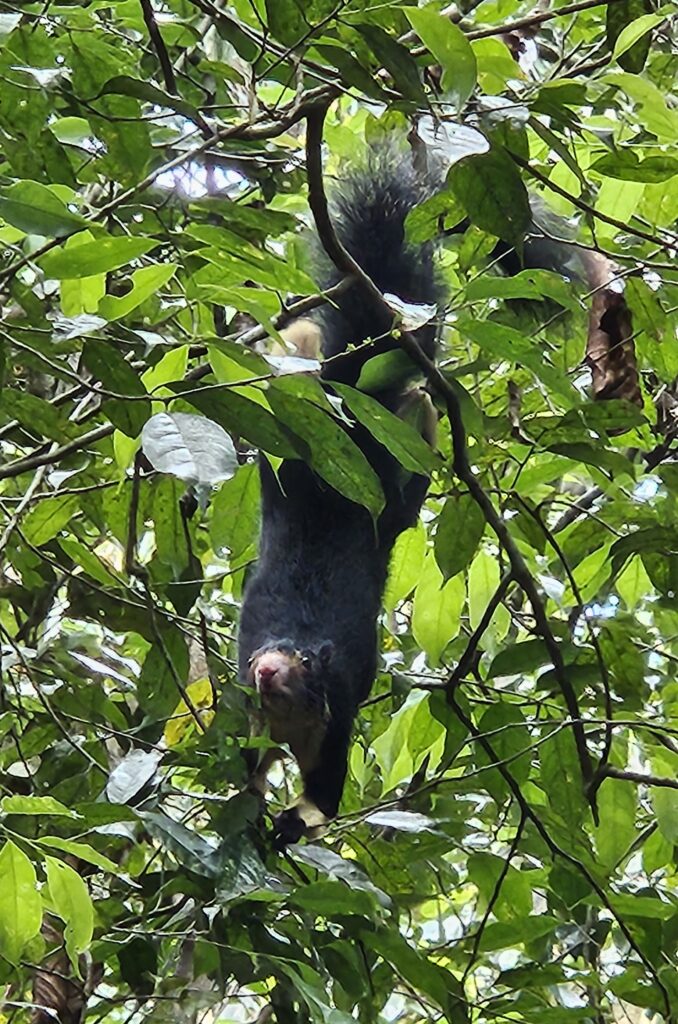
Squirrels
One animal in Sinharaja surprised us especially – we didn’t even know that grizzled giant squirrels (Ratufa macroura) exist. They are among the largest species of squirrels in the world.
We had often seen the smaller squirrels – the dusky palm squirrel (an endemic species, Funambulus obscurus) and the Indian palm squirrel (Funambulus palmarum) – in Sri Lanka before, but a squirrel over 30 centimeters long? The tail is not included in that measurement, and it’s about the same length again. What a lucky encounter to see it!
Water Buffalo
Water buffalo (Bubalus bubalis) prefer to stay in wetlands, rice fields and marshy meadows. In Sri Lanka, they are often found near water sources, where they wallow to cool down and keep parasites at bay.
They play an important role in traditional agriculture, especially in plowing rice fields. Their calm temperament and strength make them valued working animals in rural areas. In Sri Lanka, both domesticated and feral water buffalo can be found. The wild ones are more shy and tend to live in remote areas, while the tamer ones often graze near villages.
In some regions, water buffalo are seen as symbols of fertility and prosperity. Their milk – particularly when made into buffalo curd – is a local delicacy.
It’s especially impressive to see mothers with their calves. They usually move slowly and have a calm, almost stoic presence. Thanks to our patient tuk-tuk driver, we were able to observe this scene up close and undisturbed – a truly special experience.
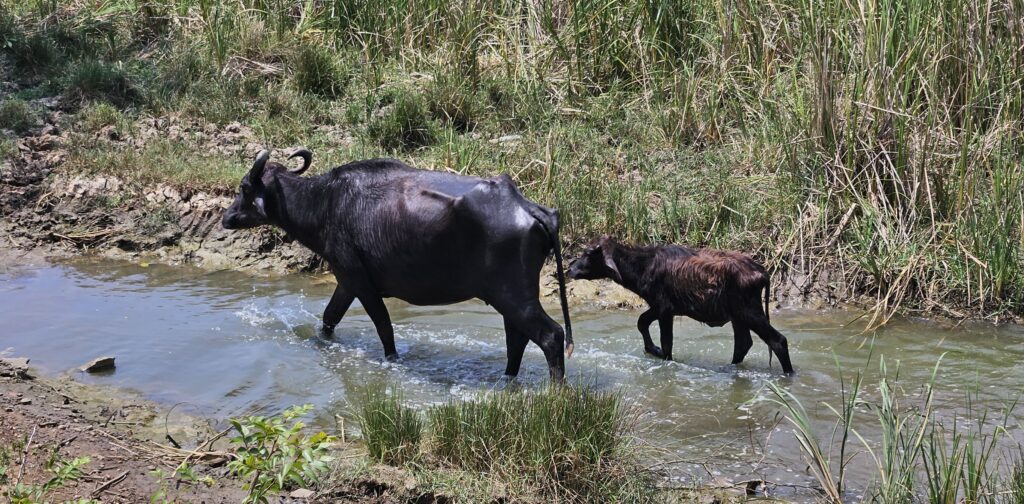





Leave a Reply